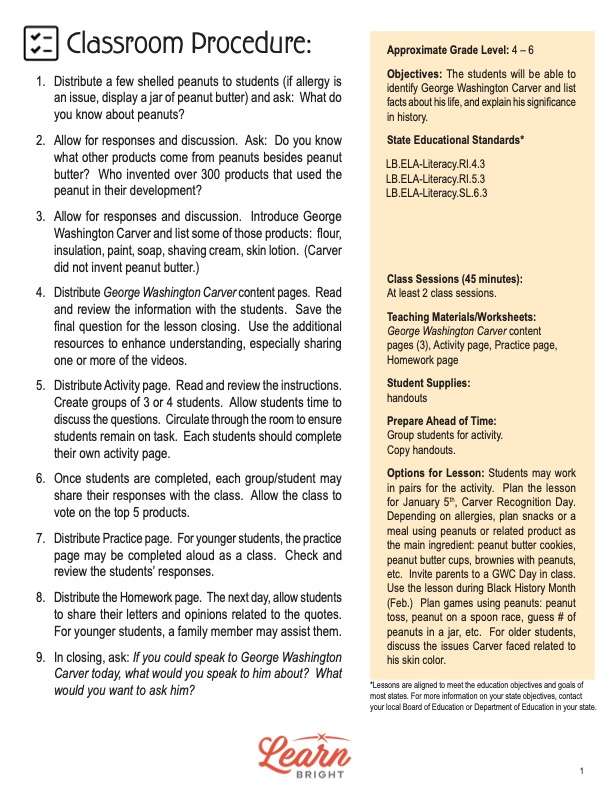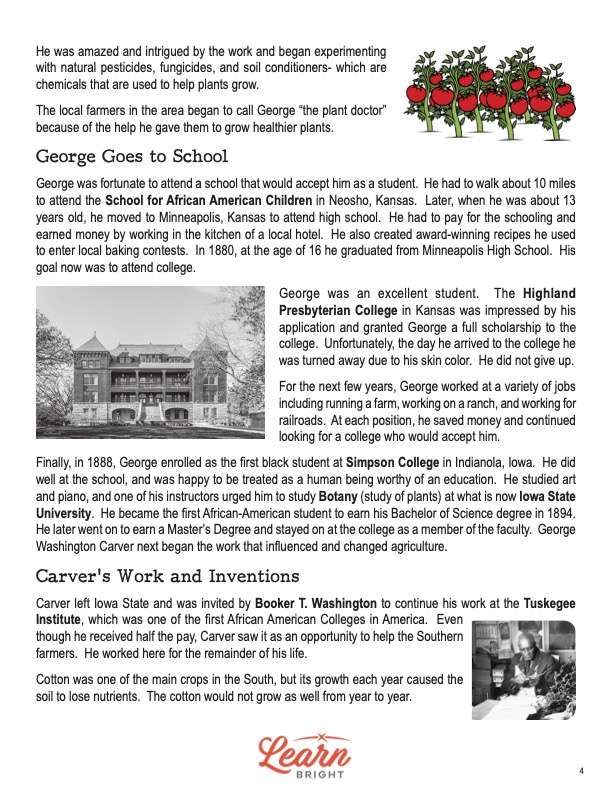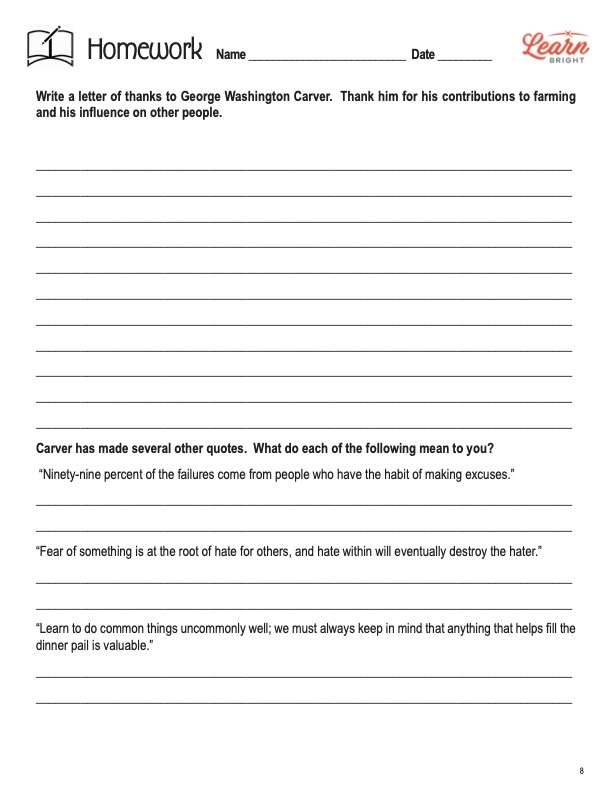Description
What our George Washington Carver lesson plan includes
Lesson Objectives and Overview: George Washington Carver explores the life of the famous inventor who is most well known for his work related to peanuts. Students will learn who he was and why he is important, as well as some more facts about his life. This lesson is for students in 4th grade, 5th grade, and 6th grade.
Classroom Procedure
Every lesson plan provides you with a classroom procedure page that outlines a step-by-step guide to follow. You do not have to follow the guide exactly. The guide helps you organize the lesson and details when to hand out worksheets. It also lists information in the yellow box that you might find useful. You will find the lesson objectives, state standards, and number of class sessions the lesson should take to complete in this area. In addition, it describes the supplies you will need as well as what and how you need to prepare beforehand. The only supplies needed for this lesson are the handouts. To prepare for this lesson ahead of time, you can divide students into their groups for the activity and copy the handouts.
Options for Lesson
Included with this lesson is an “Options for Lesson” section that lists a number of suggestions for activities to add to the lesson or substitutions for the ones already in the lesson. For this lesson, these options include letting students work in pairs for the activity, planning the lesson for January 5th, which is Carver Recognition Day, and planning snacks or meals using peanuts or related products as the main ingredient (depending on classroom allergies). These snacks or meals could include peanut butter cookies, peanut butter cups, brownies with peanuts, and more.
You could also invite parents to a George Washington Carver Day in class or use this lesson during Black History Month (February). You can also plan games using peanuts, like peanut toss, peanut on a spoon race, guess the number of peanuts in a jar, and more. If you’re teaching older students, you can also focus more of your time during this lesson on the discrimination Carver faced during his lifetime due to the color of his skin.
Teacher Notes
The teacher notes page includes a paragraph with additional guidelines and things to think about as you begin to plan your lesson. It reminds teachers that many students may not be familiar with Carver and his legacy. Emphasize that many of his inventions and innovations are still used today. This page also includes lines that you can use to add your own notes as you’re preparing for this lesson.
GEORGE WASHINGTON CARVER LESSON PLAN CONTENT PAGES
Carver’s Early Life
The George Washington Carver lesson plan contains three pages of content. Because of his discoveries, we credit George Washington Carver with saving the agricultural economy of the rural South in the early 1900s. Although he was born into slavery, he became one of the most prominent names in American history and has been an inspiration for many people. We recognize him as a famous scientist, inventor, and educator.
George was born in 1864, but we don’t know the exact birth date because the information about children born to slaves was not recorded. He was born on a farm owned by Moses Carver in Diamond, Missouri, when it was legal for plantation owners to use slaves. Both of his parents were slaves. His father was likely killed in a farming accident before George was born. George lived with his mother, several sisters, and one brother.
Around this time, the Civil War was coming to an end. When George was less than a month old, Confederate raiders kidnapped him, one of his sisters, and his mother. The kidnappers sold them to someone in Kentucky. Luckily, someone who worked for Moses Carver found George and returned him to the Missouri farm. Moses and his wife raised George and his brother. They also taught both boys how to read.
Students will learn that George was not a strong child and was unable to work in the fields like his older brother James. Instead, his foster mother—Susan—taught him how to work in the kitchen garden, tend to plants, and make herbal medicines. The work intrigued him, and he began experimenting with natural pesticides, fungicides, and soil conditioners that help plants grow. The local farmers in the area began to call George “the plant doctor” because of the help he gave them to grow healthier plants.
George Goes to School
George was fortunate to attend a school that would accept him as a student, the School for African American Children in Neosho, Kansas. Later, when he was about 13 years old, he moved to Minneapolis, Kansas, to attend high school. He had to pay for the schooling and earned money by working in the kitchen of a local hotel. He also created award-winning recipes he used at local baking contests. In 1880, he graduated from Minneapolis High School at the age of 16.
George was an excellent student. The Highland Presbyterian College in Kansas was impressed by his application and granted him a full scholarship to the college. Unfortunately, the day he arrived to the college, he was turned away due to his skin color. But he did not give up. For the next few years, George worked a variety of jobs, including running a farm, working on a ranch, and working for railroads. At each position, he saved money and continued looking for a college that would accept him.
Finally, in 1888, George enrolled as the first black student at Simpson College in Indianola, Iowa. He did well at the school and was happy to be treated as a human being worthy of an education. Carver studied art and piano, but one of his instructors urged him to study botany at what is now Iowa State University. He became the first African-American student to earn his bachelor of science degree in 1894. He later went on to earn a master’s degree and stayed on at the college as a member of the faculty.
Carver’s Work and Inventions
The last page describes the work that influenced and changed agriculture. Carver left Iowa State after Booker T. Washington invited him to continue his work at the Tuskegee Institute, which was one of the first African American Colleges in America. Even though he received half the pay, Carver saw it as an opportunity to help the Southern farmers. He worked here for the remainder of his life.
Cotton was one of the main crops in the South, but its growth each year caused the soil to lose nutrients. The cotton would not grow as well from year to year. Carver discovered that if farmers would rotate their crops. the soil would stay enriched. If they grew cotton one year, they should plant sweet potatoes and soybeans the next year. Farmers became more successful, which also allowed them to expand production.
Next came the peanut plants. A major problem for cotton growers was a certain pest—boll weevils. The insect would feed off the cotton crop. Carver learned that these bugs did not like peanuts. But the farmers worried that they could not earn an income from peanuts. Carver became motivated by the problem and discovered hundreds of new peanut products. These included cooking oil, clothing dyes, plastics, fuel for cars, and—of course—his version of peanut butter.
George Washington Carver—the Farmer’s Friend
Throughout the South, Carver earned another nickname, the farmer’s friend. Chatter about the work he was doing for farmers spread throughout the world. He helped Mahatma Gandhi grow crops throughout India. In addition, he advised President Theodore Roosevelt and the Department of Agriculture on matters related to farming.
Many people think of peanuts when they hear the name George Washington Carver, but his legacy includes much more. Because of Carver’s influence, the peanut industry grew to be a $200-million-dollar-per-year product in the United States in 1938, and it was the main crop in Alabama. The list of Carver’s accomplishments is endless.
Carver died on January 5, 1943. His life savings of $60,000 was used to found the George Washington Carver Institute for Agriculture at Tuskegee. There is also a monument dedicated to him in Diamond, Missouri. In addition, there are many other schools, scholarships, and honors named after Carver. January 5 is celebrated as George Washington Carver Recognition Day.
George Washington Carver had only three of his inventions patented, but he was not upset about it. He once said, “It is not the style of clothes one wears, neither the kind of automobile one drives, nor the amount of money one has in the bank that counts. These mean nothing. It is simply service that measures success.”
GEORGE WASHINGTON CARVER LESSON PLAN WORKSHEETS
The George Washington Carver lesson plan includes three worksheets: an activity worksheet, a practice worksheet, and a homework assignment. You can refer to the guide on the classroom procedure page to determine when to hand out each worksheet.
GEORGE WASHINGTON CARVER ACTIVITY WORKSHEET
As an activity, students will work in groups to answer questions about Carver’s life and inventions. You can have them work alone or with partners instead if you prefer. Students will explain crop rotation using pictures and words. They will also look at a list of products Carver created from various foods and discuss which are the most important and which are their personal favorites.
ORDERING PRACTICE WORKSHEET
For the practice worksheet, students will place important events from Carver’s whole life in order. They will also answer reading comprehension questions that relate to the content pages, which will require some critical thinking.
WRITING HOMEWORK ASSIGNMENT
In the homework assignment, students will first write a thank-you letter to George Washington Carver. They will then read some of his quotes and write what those quotes mean to them.
Worksheet Answer Keys
The end of this lesson plan includes answer keys for the activity worksheet, practice worksheet, and homework assignment. Given the nature of some of these prompts, students’ answers will vary. If you choose to administer the lesson pages to your students via PDF, you will need to save a new file that omits these pages. Otherwise, you can simply print out the applicable pages and keep these as reference for yourself when grading assignments.










